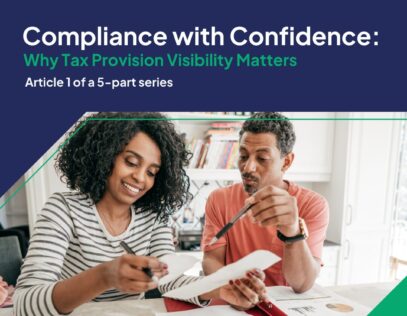5 Mistakes Smart Companies Make Preparing the Income Tax Provision
Admit it. If there’s one thing you dread every year, it’s preparing the annual corporate income tax provision. The corporate tax tell-all requires countless balances to sync, calculations to make, journal entries to explain—and how’s this for pressure?
You have about a week to do it (if you’re lucky). Then there’s the microscope you’re working under: The income tax provision is the greatest indicator of how your company fares from a tax position.
So naturally, the C-suite, shareholders, investors, and regulators are extremely interested in reviewing the results—needless to say, accuracy is a must.
Given the high stakes, the mountains of data, and the tight turnaround time, it’s no wonder that even the shrewdest tax executives occasionally trip up on the income tax provision. Some fail to confirm important information.
Others inadvertently omit end-of-the-year line items. And many work in tax silos, having no idea about the game-changing business moves that other departments are planning. And while these may sound like rookie mistakes, we’re willing to bet that even your tax department has at one time or another tripped over an income tax provision blunder or two.
What are some common income tax provision mistakes and how can your tax team avoid them? Here, we reveal the errors that we see time and again—along with expert advice on how to steer clear of them.
Mistake #1: You don’t coordinate and plan with your accounting and finance departments.
Amounts from balance sheets, income statements, and accounting ledgers are obviously important ingredients in calculating your company’s provision—and is it us or do accounting and finance take their sweet time closing those pre-tax books, making a tight deadline painfully tighter?
Granted, the waiting game with accounting is difficult, but what’s worse is when the books reveal major events have taken place unbeknownst to the tax department.
Maybe an acquisition was made, an entity was sold, an unusual transaction occurred, or budgets were revised—whatever the case, learning about significant business transactions after-the-fact leaves tax executives powerless in terms of navigating the tax consequences of those decisions.
It also makes it difficult to plan a provision process around them and calculate tax balances accurately. Preparing the income tax provision is a time-crunch as it is—if you’re lucky, you’ll have two days to prepare quarterly provisions and a week for the annual—and it entails mountains of technical work, calculating the income tax expense, income tax payable, deferred items, and finally, the star of the show: the effective tax rate.
If the tax department learns of a business transaction the week the provision is due, there’s not only no time to strategize from a tax perspective, but also very little time to determine the proper tax treatment. So, you’re left vulnerable to a potentially higher-than-necessary effective tax rate, or maybe even worse, an error—and very unhappy shareholders and executives in either scenario.
Avoid the Same Mistake: Give tax a regular seat at the business table.
Strategic tax planning and accurate, timely reporting requires one key ingredient: information. And if you’re getting that information after-the-fact then you’re not involved in strategic planning at all—in fact, you’re just playing defense.
(Not a great global tax strategy, by the way.) With ahead-of-the-game intelligence, you can see tax consequences before you’re saddled with them. Knowing about new ventures before they’re finalized also means you can help the C-suite understand the tax implications of major events—a huge advantage, as CEOs and CFOs will probably be the ones defending new business transactions and their tax implications to the board.
Plus, if tax learns of new business plans before they’re executed, they can present proposed tax treatments to auditors and get buy-in—or not—on the front end, which is a lot better than having an auditor recast or question things during crunch time.
Making the tax department part of the new business process is not just intelligent tax planning—it’s a shrewd business strategy. If you know you’re going to have net operating losses (NOL), do you want them wasting away in a low- or no-tax jurisdiction?
Could an acquisition be structured to absorb less tax liability? Do unidentified tax assets exist in an entity that’s about to be spun off? What are the transfer pricing implications of working in a new jurisdiction?
Do R&D tax incentives make setting up shop in one country more desirable than another? This is the kind of unique insight that only the tax department can bring—and by doing so, can add significantly to your bottom line.
Mistake #2: You fail to prove out your deferreds.
We get it: Tax departments are busy. You don’t have time to revisit every calculation, especially when you’re already working on such tight deadlines. And so, to save time, when you prepare your income tax provision, you don’t dive as deep as you could into your deferred tax assets and liabilities.
Instead, you take the deferred items from last year, layer in the current year’s activity, add them together—and voila!—you have an ending balance and you’re done. What a relief, right? Wrong.
Deferreds are the product of temporary differences between tax and accounting, along with tax attributes like net operating losses and credits, and they’re also an area of your tax provision where it’s easy to trip up.
For instance, it’s easy to exclude or misstate a temporary difference that arose during the year from the deferred tax calculation, which would, of course, lead to errors on your balance sheet and, via domino effect, your annual income tax provision.
Need we remind you: Incorrect tax reporting is one of the leading causes of adverse auditor opinions and financial restatements—and if a company has to restate its financials, well, that could have disastrous consequences (regulatory penalties, falling stock prices, negative publicity, layoffs, etc.), both internally and externally.
Failing to prove out deferred tax assets and liabilities is just part of the problem. Not only do tax executives fail to confirm their data, but they also forget to actually look at the data and ask themselves: Do these numbers really make sense? If you can’t make sense of what the numbers are telling you, then an auditor won’t be able to either—and that’s where problems begin.
Avoid the Same Mistake: Practice due diligence and prove out deferreds.
To make sure the numbers are flowing properly—and to make sure they are telling a consistent and logical story—tax professionals typically review the beginning balances on their deferred roll-forward schedules and compare those balances to those reported on prior-year financial statements.
Next, they add in current activity from the current provision, layer in any return-provision true-ups, include any deferred-only and balance-sheet-only adjustments, and add it all up to get to their end-of-year balances.
This is all well and good—but what if the beginning balance is off? Or what if the current year activity has an error within? Prove out your gross deferred tax assets and liabilities by comparing the net book value of items versus the net tax value. Sure, it’s an investment of time but you can’t just roll forward values year after year without validating the numbers.
Once you’ve determined you have the correct numbers in place, then it’s time to take it a step further and look at what the numbers are telling you. Do they align with the reality of the business?
For instance, if your company had significant fixed-asset purchases during the year, and you’re reporting a deferred tax asset related to fixed assets rather than a deferred tax liability, something may be amiss—or at the very least, require further explanation. Proving out deferreds helps you connect with the numbers and, most importantly, make sense of them.
Mistake #3: You plug your rate reconciliation incorrectly.
The effective tax rate is the king of metrics, a powerful number that reveals how a company fares from a tax perspective, and it’s arguably the most important calculation in the income tax provision. Internally, CEOs and CFOs are both interested in a company’s effective tax rate—it reveals to them not only how much of a toll tax takes on earnings, but also the efficiency of the tax function overall.
Maybe a company is paying too much tax and should consider merging entities to reduce a tax bill. Or maybe it signals that a company needs to shift losses into a higher tax jurisdiction or dispose of an entity altogether. A company’s effective tax rate can indicate which tax strategies should be employed.
The effective tax rate is also a way for the tax department to gauge its own performance. Tax executives will compare this year’s effective tax rate to last year’s, and the year before, and say, “Why did it change year over year?”
High-level executives also compare quarter over quarter to see changes—that can mean comparing this year’s Q3 to last year’s Q3 or comparing this year’s Q3 to this year’s Q2 and Q1. They’ll also compare it to other companies in the industry, as well, to see how their effective tax rates compare to competitors.
Given that a company’s effective tax rate is such a hugely important number, it’s important to know how a company arrived at that rate. So, as part of the income tax provision, regulators expect a detailed picture of a company’s journey from their home-country’s statutory tax rate to their effective tax rate.
Were there tax credits? Stock compensation? A foreign-rate differential? Demonstrating the journey from the statutory rate to the effective tax rate is known as rate reconciliation.
But sometimes—often in the 11th hour—you find that the rates you’re trying to reconcile don’t prove out. Maybe there’s an accounting error. Maybe a data entry error. So, you “plug” the rate reconciliation—inserting an artificial adjustment or placeholder—to make sure everything ties together.
The problem? If you have to plug your rate reconciliation, then you’re missing something.
A calculation is off, and you don’t know where. If you haven’t identified the root cause, you could have multiple material issues offsetting each other, which will throw off your effective tax rate—that all-important number coveted by stakeholders, executives, and auditors—and therefore your income tax provision overall.
Avoid the Same Mistake: Skip the quick fix and find out why the numbers don’t prove out.
How many times do we have to say it? Tax issues are one of the largest causes for financial restatements, and in recent years, the effective tax rate has become even more important to investors, analysts, and regulators. So, do some digging, prove out your rate reconciliation, and discover exactly what’s driving your company’s effective tax rate.
Mistakes often occur with deferred assets, so start by revisiting your deferred tax calculation, and make sure your deferred tax expense is correct, and that you have included all applicable items that impact the rate in the rate reconciliation.
Review the current tax calculations from the current year and ensure all items impacting the rate are included in the reconciliation.
Another place mistakes commonly hide: the state provision. Given that the state provision is less material than the federal, tax executives may take shortcuts to it, potentially causing the rate to not reconcile.
Make proving out your rate reconciliation a natural part of the income tax provision process. Assign it to staff members and budget time for it. So, if your rates don’t check out, you’ll understand why and be able to correct the problem before it becomes a crisis.
Mistake #4: You involve the financial statement auditor at the 11th hour.
Mergers and acquisitions. Entity sales. Property, plant, and equipment purchases. Businesses are complicated. And all of a company’s business transactions must be documented by accounting and tax—and often, the treatment requires serious judgment calls. What is the fair market value of an acquisition?
How should a purchase price be allocated in terms of assets and liabilities? Which accounting treatment should be applied to an entity spin-off? Are deferred tax assets overstated? How much of a valuation allowance is in order? Are there any uncertain tax positions?
When it comes to preparing a tax provision and financial statements, time is of the essence. So, who could blame you for taking matters into your own hands and reserving for deferred assets based on probable forecasts? Or allocating assets and liabilities to the best of your knowledge? After all, if something is off, the auditor will catch it and you can make adjustments then.
Trouble is, by the time an auditor raises a question about your financial statements, there’s already a domino effect at work. If an amount is recorded incorrectly on a balance sheet, then it flows incorrectly onto your income statement, and ultimately, your overall income tax provision, profit and loss, and balance sheet are suddenly off.
Numbers from one report affect calculations and treatments on others. So, if at the 11th hour your auditor questions your tax treatment of an acquisition, suddenly, you may have a trail of calculations and reports to redo.
Not only is that more work than you have time for, but stressful situations that arise on deadline make financial and tax reporting more prone to errors.
Avoid the Same Mistake: Involve auditors early on.
What if, instead of waiting for the auditor to review your financial statements, you collaborated with the auditor before you solidified any tax treatments? Think about it. “I don’t think these deferred assets will ever be realized. I’m thinking we need a valuation allowance in the amount of X.
Would you agree?” “We need to allocate $10 million as the fair market value of property, plant, and equipment (PP&E). Do you think that amount is correct?”
If the auditor disagrees, you can come up with a solution together, avoiding questions, a trail of corrections, and last-minute stress. Then when it is time for the audit, the auditor is already familiar with your transactions and knows how and why certain transactions received certain tax treatments.
This kind of collaboration builds trust—a key ingredient for a smooth financial statement audit—and saves time on the backend. Proactively alleviating your auditor’s concerns helps to significantly reduce the possibility of error identification, modified opinions, and misstatements.
Involving an auditor early on sets you up for a smooth audit process and a good relationship with your auditor. Early collaboration can offer insight into where a business might want to tighten controls and result in a clean opinion, delivered swiftly—both of which will undoubtedly please your shareholders.
Mistake #5: You don’t embrace technology.
Rate reconciliation, deferred income tax expense, temporary differences, permanent differences. So many steps, rules, and reports go into preparing the income tax provision. And before you dive into any calculations, you’ll need to gather data from all over the company and make sure every balance matches its corresponding account. Grueling? Tedious? You bet.
But then those initial steps tend to be the easy part of preparing the income tax provision. Taking those numbers and calculating the current year’s temporary differences, permanent differences, and appropriately applying credits and NOLs, and making sure all of those numbers sync up with the rest of your financials, that’s the hard part.
And as we keep mentioning, the tight turnaround time—when you’re preparing the provision, you’re always on deadline—and with great visibility. That’s right, everyone’s watching—shareholders, investors, and the C-suite—and all waiting to see what that effective tax rate is and how it compares to past years and competitors in the industry.
So, if you’re preparing the provision manually, well then, you’re making the job even harder. Are the numbers consistent from one to the other? Have fun combing through each one to find out.
Once you realize you have the correct data, you’ll have to manually enter or link them into Excel, a program that often means flipping between worksheets, losing links, struggling with journal entries—and possibly tearing your hair out.
Avoid the Same Mistake: Embrace tax software.
Fortunately, there is a way to make preparing the income tax provision—and your life—easier: Tax software. Technology guarantees seamlessness, time-savings, and accuracy, but if you’re worried about it replacing actual human beings, don’t. Tax software takes care of those monotonous, tediousness jobs that can be easily automated, freeing you up to tackle the ones that require strategic thinking.
When it comes to something as layered and technical as the income tax provision, tax software can spare you the headaches of complex calculations, not to mention, a few late nights at the office.
Tired of typing in the same information on report after report? Software can take account numbers, industry information, and company data and export it onto corresponding tax documents.
It can also review this year’s documents to ensure they align with prior years—and remember those long hours reconciling book accounts to tax? Well, no more—tax software can help expedite and automate book-to-tax differences for you.
No doubt, knowing how your tax position in the U.S. is important—but how are you doing in other jurisdictions around the world? With tax software, you can click on a jurisdiction and see your effective tax rate in that country.
It even lets you know in which jurisdictions you have income tax provision data in progress and which provisions are complete, and it provides all of the relevant data on a country-by-country basis.
Wondering what your effective tax rate looks like if you shift losses from Entity A in X Jurisdiction to Entity B in Y Jurisdiction? Software puts the answer at your fingertips by showing you how a change to your provision impacts your effective tax rate on a country-by-country basis.
You can also enlist software to take stock of trends. Want to compare a previous provision against the current period? Done. Technology provides charts so, in one glance, you can see how changes in tax credits, permanent differences, valuation allowances, foreign rate differentials, and other factors impact your effective tax rate.
No doubt you’ll have to explain to shareholders, executives, and auditors why your effective tax rate has changed from period to period, but with technology you won’t have to do a manual analysis to figure it out—tax software does it for you.
Tax executives are often asked to predict the future and software is the next-best thing to a crystal ball. It enables you to create “what if” scenarios by changing pre-tax book income or rate drivers to explore different outcomes. Export those insightful analyses and present them to stakeholders and you can confidently strategize the tax implications of your next business move.
The short of it is, given that the income tax provision is such a technical, fact-finding mission—and that you’re up against the clock preparing it—tax software is a necessity, not a luxury.
Not only does it save time, money, and resources, but it streamlines processes and information, tackles complicated calculations, flags numbers that don’t align, and guarantees accuracy—all of which are key to avoiding common income tax provision mistakes.







